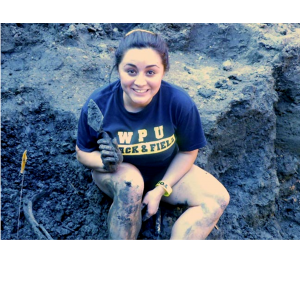William Penn University faculty and students get their hands dirty

Muddy legs and mammoth ribs. WPU student, Karin Stewart participates in the mammoth dig. (submitted photo)
Oskaloosa, IA- Dr. James North, Chair of the Health and Life Sciences Division at William Penn University, and other members of the William Penn faculty, have taken an active role in the excavation of mammoth remains discovered in rural Oskaloosa, Iowa. Dr. North has participated in several of the on-site digs, along with some of his students. “To be a part of such a rare and unique discovery has been really exciting,” stated North.
The rare find has sparked the interest of educators and natural history enthusiasts from across the state. The site has been opened to volunteers and educators in the area to serve as an educational tool for students of all ages. Dr. Janet Ewart, Associate Professor of Biology at William Penn University, took her Comparative Anatomy class to the site for the September dig. Students had the chance to get their hands, and shoes, dirty as they uncovered the prehistoric remains buried over 10 feet below the surface. After a day of digging through the mud and muck, students had uncovered a few rib bones, a piece of a tusk, vertebra, and other various remains. Dr. Ewart said of the experience, “This is something students will remember for the rest of their lives.”
Dr. North has been working with the Educational Director of the University of Iowa Museum of Natural History, Sarah Horgen, along with University of Iowa professor emeritus, Holmes Semken, and Director of the Indian Creek Nature Center, David Brenzel. Using both advanced technology and hands-on labor, over 50 bones have been uncovered since the initial discovery in the summer of 2010. Scientists continue to discover other clues to our history, including plant and tree samples that will indicate what the environment was like during the mammoth’s life and death.
Activity has recently increased at the site where scientists, geologists and volunteers have discovered the remains of not one, but two, mammoths. To find such a large number of bones from one mammoth in one location is rare, but to find remains of two separate individuals is quite spectacular. As the winter months approach, the dig directors are working quickly to ensure that any uncovered remains are well protected before the harsh temperatures and elements of winter arrive.
The William Penn University Health and Life Sciences Division, with its close proximity to the site, has offered site directors complete access to all lab equipment, including use of the high-powered Scanning Electron Microscope (SEM), which would examine the findings on a microscopic level. “The SEM will allow us to observe surface structures and trace elements, which will help us determine the environmental conditions where the mammoths lived,” said Dr. North.
The William Penn University faculty and students are thrilled to be a part of such an exciting discovery. Photos and updates from the dig site can be found on our blog at wpumammothdig.tumblr.com.










